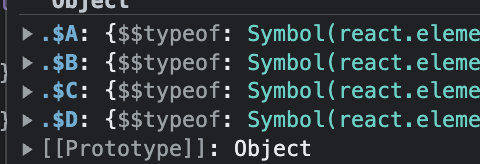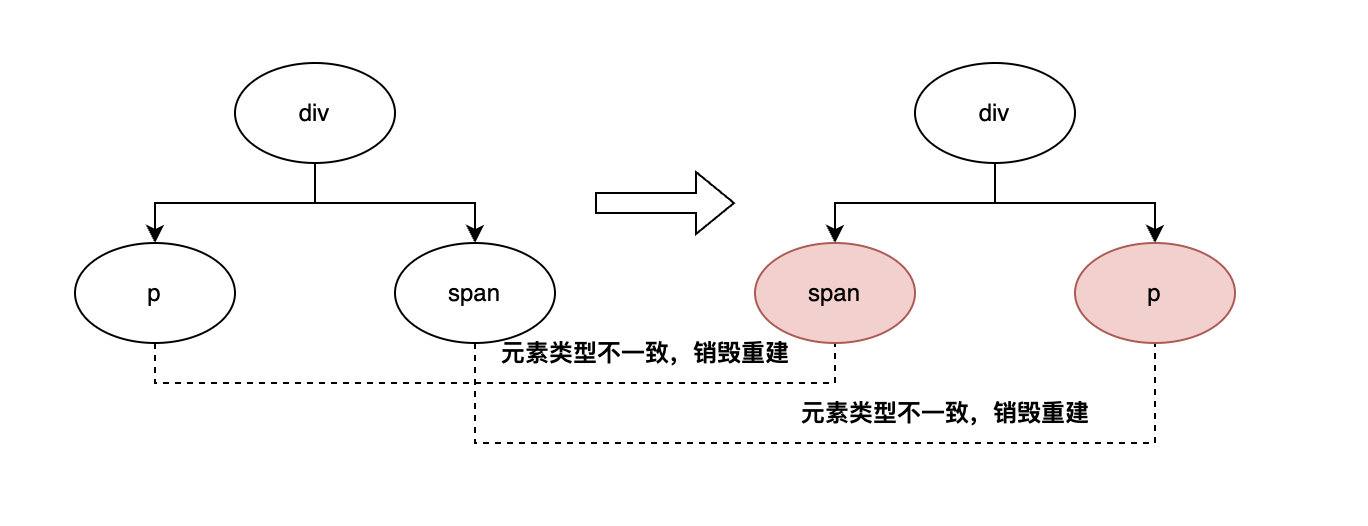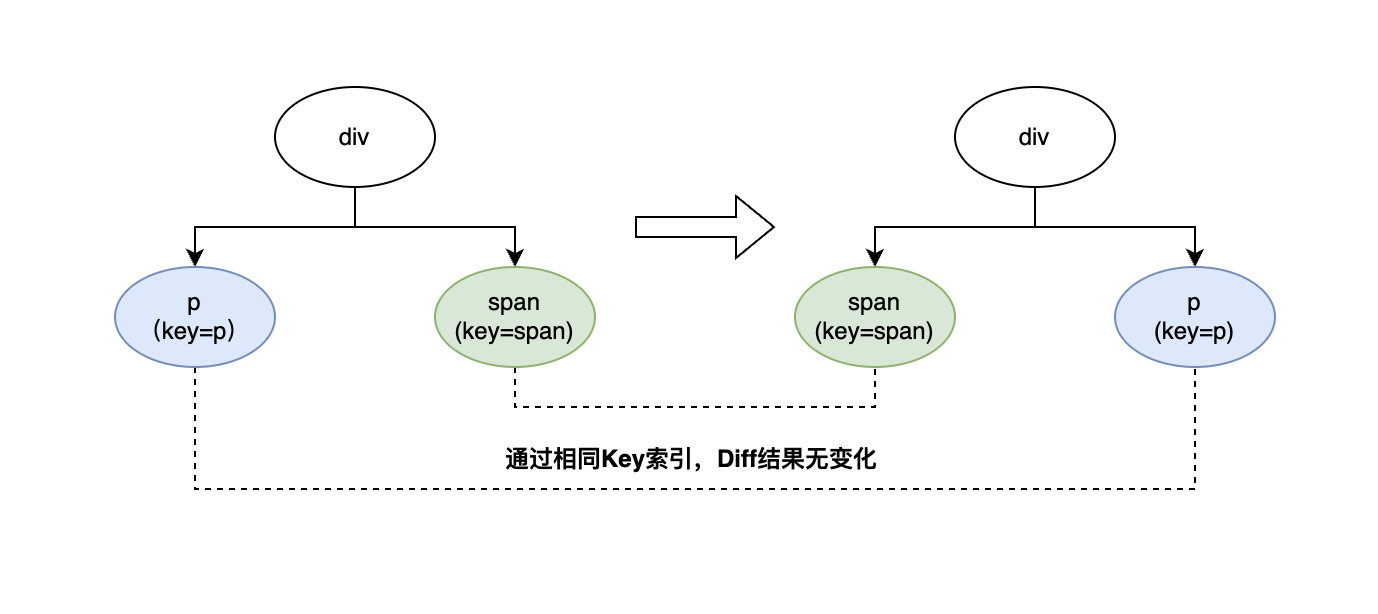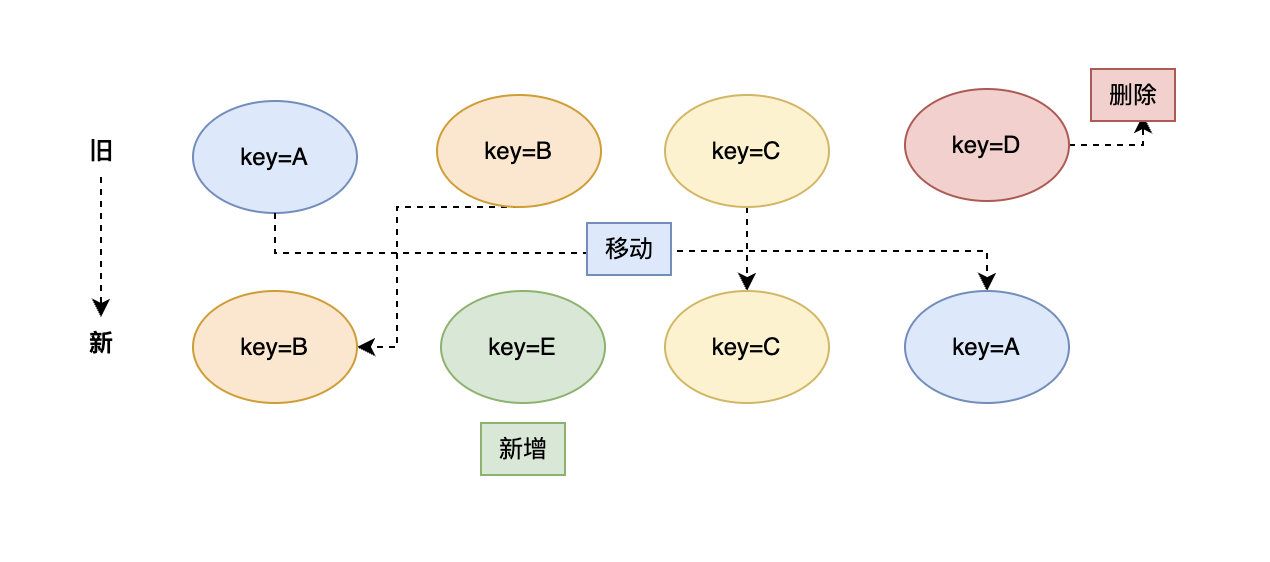React源码学习入门(十二)DOM组件更新流程与Diff算法
本文基于React v15.6.2版本介绍,原因请参见新手如何学习React源码
源码分析
前面提到过最终的更新还是要在DOMComponent完成,而setState后,触发到DOM的更新入口是receiveComponent,源码在src/renderers/dom/shared/ReactDOMComponent.js:
receiveComponent: function(nextElement, transaction, context) {
var prevElement = this._currentElement;
this._currentElement = nextElement;
this.updateComponent(transaction, prevElement, nextElement, context);
},实际上updateComponent我们之前在挂载过程中提到过,现在我们来关注里面的更新逻辑:
updateComponent: function(transaction, prevElement, nextElement, context) {
var lastProps = prevElement.props;
var nextProps = this._currentElement.props;
this._updateDOMProperties(lastProps, nextProps, transaction);
this._updateDOMChildren(lastProps, nextProps, transaction, context);
},省略其他分支,更新逻辑是由properties更新和children更新完成的,先看看properties:
_updateDOMProperties: function(lastProps, nextProps, transaction) {
var propKey;
var styleName;
var styleUpdates;
// 1. 处理旧的Props
for (propKey in lastProps) {
if (
nextProps.hasOwnProperty(propKey) ||
!lastProps.hasOwnProperty(propKey) ||
lastProps[propKey] == null
) {
continue;
}
// 注意判断条件,只有nextProps没有的才会走到这里,意味着这里需要做删除操作
// 1.1 处理旧的style属性,清空styleUpdates对应的属性
if (propKey === STYLE) {
var lastStyle = this._previousStyleCopy;
for (styleName in lastStyle) {
if (lastStyle.hasOwnProperty(styleName)) {
styleUpdates = styleUpdates || {};
styleUpdates[styleName] = '';
}
}
this._previousStyleCopy = null;
}
// 1.2 处理旧的事件属性,先删除旧的监听器
else if (registrationNameModules.hasOwnProperty(propKey)) {
if (lastProps[propKey]) {
deleteListener(this, propKey);
}
}
// 1.3 处理旧的属性,删除旧的属性
else if (
DOMProperty.properties[propKey] ||
DOMProperty.isCustomAttribute(propKey)
) {
DOMPropertyOperations.deleteValueForProperty(getNode(this), propKey);
}
}
// 2. 处理新的属性
for (propKey in nextProps) {
var nextProp = nextProps[propKey];
var lastProp = propKey === STYLE
? this._previousStyleCopy
: lastProps != null ? lastProps[propKey] : undefined;
if (
!nextProps.hasOwnProperty(propKey) ||
nextProp === lastProp ||
(nextProp == null && lastProp == null)
) {
continue;
}
// 2.1 处理新的样式属性
if (propKey === STYLE) {
if (nextProp) {
nextProp = this._previousStyleCopy = Object.assign({}, nextProp);
} else {
this._previousStyleCopy = null;
}
if (lastProp) {
// 和前面的处理一样,对于之前的style标签,如果next里面没有的,需要清空
for (styleName in lastProp) {
if (
lastProp.hasOwnProperty(styleName) &&
(!nextProp || !nextProp.hasOwnProperty(styleName))
) {
styleUpdates = styleUpdates || {};
styleUpdates[styleName] = '';
}
}
// 更新新的样式属性
for (styleName in nextProp) {
if (
nextProp.hasOwnProperty(styleName) &&
lastProp[styleName] !== nextProp[styleName]
) {
styleUpdates = styleUpdates || {};
styleUpdates[styleName] = nextProp[styleName];
}
}
} else {
// 全新的样式属性
styleUpdates = nextProp;
}
}
// 2.2 处理新的事件
else if (registrationNameModules.hasOwnProperty(propKey)) {
if (nextProp) {
enqueuePutListener(this, propKey, nextProp, transaction);
} else if (lastProp) {
deleteListener(this, propKey);
}
}
// 2.3 处理新的属性
else if (
DOMProperty.properties[propKey] ||
DOMProperty.isCustomAttribute(propKey)
) {
var node = getNode(this);
if (nextProp != null) {
DOMPropertyOperations.setValueForProperty(node, propKey, nextProp);
} else {
DOMPropertyOperations.deleteValueForProperty(node, propKey);
}
}
}
if (styleUpdates) {
CSSPropertyOperations.setValueForStyles(
getNode(this),
styleUpdates,
this,
);
}
},对于更新属性的逻辑,和前面提到的非常类似,只是增加了删除的处理:
更新Style属性,因为style本身是一个对象,因此要遍历style中的每个key,对比新老对象来处理是删除还是更新。
更新事件属性,这里只需要根据新属性的有无来判断是新增还是删除
更新其他DOM属性,我们只需要根据新旧属性来处理新增和删除
接下来我们重点来看一下children的更新:
_updateDOMChildren: function(lastProps, nextProps, transaction, context) {
var lastContent = CONTENT_TYPES[typeof lastProps.children]
? lastProps.children
: null;
var nextContent = CONTENT_TYPES[typeof nextProps.children]
? nextProps.children
: null;
var lastHtml =
lastProps.dangerouslySetInnerHTML &&
lastProps.dangerouslySetInnerHTML.__html;
var nextHtml =
nextProps.dangerouslySetInnerHTML &&
nextProps.dangerouslySetInnerHTML.__html;
var lastChildren = lastContent != null ? null : lastProps.children;
var nextChildren = nextContent != null ? null : nextProps.children;
var lastHasContentOrHtml = lastContent != null || lastHtml != null;
var nextHasContentOrHtml = nextContent != null || nextHtml != null;
if (lastChildren != null && nextChildren == null) {
this.updateChildren(null, transaction, context);
} else if (lastHasContentOrHtml && !nextHasContentOrHtml) {
this.updateTextContent('');
}
if (nextContent != null) {
if (lastContent !== nextContent) {
this.updateTextContent('' + nextContent);
}
} else if (nextHtml != null) {
if (lastHtml !== nextHtml) {
this.updateMarkup('' + nextHtml);
}
} else if (nextChildren != null) {
this.updateChildren(nextChildren, transaction, context);
}
},这里我们先忽略前面两个特殊的判断条件,其实逻辑非常简单:
如果更新后的是content(文本节点),则直接调用
updateTextContent如果更新后的是HTML(dangerouslySetInnerHTML),则直接调用
updateMarkup其他情况,调用
updateChildren
于是实现的重头戏应该是updateChildren:
_updateChildren: function(
nextNestedChildrenElements,
transaction,
context,
) {
var prevChildren = this._renderedChildren;
var removedNodes = {};
var mountImages = [];
// 1. 更新children
var nextChildren = this._reconcilerUpdateChildren(
prevChildren,
nextNestedChildrenElements,
mountImages,
removedNodes,
transaction,
context,
);
if (!nextChildren && !prevChildren) {
return;
}
var updates = null;
var name;
// `nextIndex` will increment for each child in `nextChildren`, but
// `lastIndex` will be the last index visited in `prevChildren`.
var nextIndex = 0;
var lastIndex = 0;
// `nextMountIndex` will increment for each newly mounted child.
var nextMountIndex = 0;
var lastPlacedNode = null;
for (name in nextChildren) {
if (!nextChildren.hasOwnProperty(name)) {
continue;
}
var prevChild = prevChildren && prevChildren[name];
var nextChild = nextChildren[name];
// 2. 在设置了key的情况下,只移动个别节点,做到算法最优
if (prevChild === nextChild) {
updates = enqueue(
updates,
this.moveChild(prevChild, lastPlacedNode, nextIndex, lastIndex),
);
lastIndex = Math.max(prevChild._mountIndex, lastIndex);
prevChild._mountIndex = nextIndex;
} else {
if (prevChild) {
// Update `lastIndex` before `_mountIndex` gets unset by unmounting.
lastIndex = Math.max(prevChild._mountIndex, lastIndex);
// The `removedNodes` loop below will actually remove the child.
}
// 3. 对于全新节点,直接插入
updates = enqueue(
updates,
this._mountChildAtIndex(
nextChild,
mountImages[nextMountIndex],
lastPlacedNode,
nextIndex,
transaction,
context,
),
);
nextMountIndex++;
}
nextIndex++;
lastPlacedNode = ReactReconciler.getHostNode(nextChild);
}
// 4. 删除旧的节点
for (name in removedNodes) {
if (removedNodes.hasOwnProperty(name)) {
updates = enqueue(
updates,
this._unmountChild(prevChildren[name], removedNodes[name]),
);
}
}
// 统一执行更新(可能包括移动、新增、删除等)
if (updates) {
processQueue(this, updates);
}
this._renderedChildren = nextChildren;
},这段代码就是React Diff算法的核心了,它主要做了以下几个事情:
先执行
_reconcilerUpdateChildren,拿到处理后的children节点经过上一步的处理,也许一些DOM节点已经更新(会调用之前说到的updateComponent),但是还可能发生移动、删除、新增的操作,这个第一步并没有处理
处理节点移动、删除、新增的情况,这也是Diff算法的核心。
接下来详细分析下这几个步骤:
首先来看看_reconcilerUpdateChildren的实现:
_reconcilerUpdateChildren: function(
prevChildren,
nextNestedChildrenElements,
mountImages,
removedNodes,
transaction,
context,
) {
var nextChildren;
var selfDebugID = 0;
nextChildren = flattenChildren(nextNestedChildrenElements, selfDebugID);
ReactChildReconciler.updateChildren(
prevChildren,
nextChildren,
mountImages,
removedNodes,
transaction,
this,
this._hostContainerInfo,
context,
selfDebugID,
);
return nextChildren;
},这里其实是调用updateChildren方法,最终返回nextChildren,值得关注的是这里有一个flattenChildren的操作,它是实现React的key机制的核心:
function flattenSingleChildIntoContext(
traverseContext: mixed,
child: ReactElement<any>,
name: string,
selfDebugID?: number,
): void {
if (traverseContext && typeof traverseContext === 'object') {
const result = traverseContext;
const keyUnique = result[name] === undefined;
if (keyUnique && child != null) {
result[name] = child;
}
}
}
function flattenChildren(
children: ReactElement<any>,
selfDebugID?: number,
): ?{[name: string]: ReactElement<any>} {
if (children == null) {
return children;
}
var result = {};
traverseAllChildren(children, flattenSingleChildIntoContext, result);
return result;
}可以看到其实flattenChildren就是把children的嵌套结构转化为对象,而它的key是由组件的key生成的,当我们没有指定key的时候,它是这样:

当我们设置key的时候,它是这样:

它的生成函数位于src/shared/utils/traverseAllChildren.js:
function getComponentKey(component, index) {
// Do some typechecking here since we call this blindly. We want to ensure
// that we don't block potential future ES APIs.
if (component && typeof component === 'object' && component.key != null) {
// Explicit key
return KeyEscapeUtils.escape(component.key);
}
// Implicit key determined by the index in the set
return index.toString(36);
}所以接下来的Diff过程,我们明白了,它完全是根据相同的key来diff,没设置key的话,其实是通过数组下标来进行(源码位于src/renderers/shared/stack/reconciler/ReactChildReconciler.js):
updateChildren: function(
prevChildren,
nextChildren,
mountImages,
removedNodes,
transaction,
hostParent,
hostContainerInfo,
context,
selfDebugID, // 0 in production and for roots
) {
if (!nextChildren && !prevChildren) {
return;
}
var name;
var prevChild;
// 这里的name实际上就是生成的key
for (name in nextChildren) {
if (!nextChildren.hasOwnProperty(name)) {
continue;
}
prevChild = prevChildren && prevChildren[name];
var prevElement = prevChild && prevChild._currentElement;
var nextElement = nextChildren[name];
if (
prevChild != null &&
shouldUpdateReactComponent(prevElement, nextElement)
) {
ReactReconciler.receiveComponent(
prevChild,
nextElement,
transaction,
context,
);
nextChildren[name] = prevChild;
} else {
if (prevChild) {
removedNodes[name] = ReactReconciler.getHostNode(prevChild);
ReactReconciler.unmountComponent(prevChild, false);
}
var nextChildInstance = instantiateReactComponent(nextElement, true);
nextChildren[name] = nextChildInstance;
var nextChildMountImage = ReactReconciler.mountComponent(
nextChildInstance,
transaction,
hostParent,
hostContainerInfo,
context,
selfDebugID,
);
mountImages.push(nextChildMountImage);
}
}
for (name in prevChildren) {
if (
prevChildren.hasOwnProperty(name) &&
!(nextChildren && nextChildren.hasOwnProperty(name))
) {
prevChild = prevChildren[name];
removedNodes[name] = ReactReconciler.getHostNode(prevChild);
ReactReconciler.unmountComponent(prevChild, false);
}
}
},这段代码我们之前分析过,要注意这里的循环是for in,代表着是从新的children,通过key来索引旧的child进行diff。
在这个函数中,它会执行receiveComponent的逻辑,这个我们之前讲过,就是用来更新组件的,要注意的是同样根据shouldUpdateReactComponent原则,来进行更新或销毁重新挂载,值得注意的是这里的挂载并不会真正执行DOM操作,而是生成DOM节点存放在mountImages中,或是删除节点存放在removedNodes中,真正的DOM操作其实是在外面。
最后返回来看一下外面这段代码:
var nextIndex = 0;
var lastIndex = 0;
// `nextMountIndex` will increment for each newly mounted child.
var nextMountIndex = 0;
var lastPlacedNode = null;
for (name in nextChildren) {
if (!nextChildren.hasOwnProperty(name)) {
continue;
}
var prevChild = prevChildren && prevChildren[name];
var nextChild = nextChildren[name];
// 1. 移动节点
if (prevChild === nextChild) {
updates = enqueue(
updates,
this.moveChild(prevChild, lastPlacedNode, nextIndex, lastIndex),
);
lastIndex = Math.max(prevChild._mountIndex, lastIndex);
prevChild._mountIndex = nextIndex;
} else {
if (prevChild) {
// Update `lastIndex` before `_mountIndex` gets unset by unmounting.
lastIndex = Math.max(prevChild._mountIndex, lastIndex);
// The `removedNodes` loop below will actually remove the child.
}
// 2. 新增节点
updates = enqueue(
updates,
this._mountChildAtIndex(
nextChild,
mountImages[nextMountIndex],
lastPlacedNode,
nextIndex,
transaction,
context,
),
);
nextMountIndex++;
}
nextIndex++;
lastPlacedNode = ReactReconciler.getHostNode(nextChild);
}
for (name in removedNodes) {
if (removedNodes.hasOwnProperty(name)) {
// 3. 删除节点
updates = enqueue(
updates,
this._unmountChild(prevChildren[name], removedNodes[name]),
);
}
}
if (updates) {
processQueue(this, updates);
}这段代码主要用来识别children最终diff出来要产生的三种行为:
移动(
moveChild)新增(
_mountChildAtIndex)删除(
_unmountChild)
先说一下最复杂的移动操作,来看一看moveChild的实现:
moveChild: function(child, afterNode, toIndex, lastIndex) {
// If the index of `child` is less than `lastIndex`, then it needs to
// be moved. Otherwise, we do not need to move it because a child will be
// inserted or moved before `child`.
if (child._mountIndex < lastIndex) {
return makeMove(child, afterNode, toIndex);
}
},可以看到,moveChild的前提条件有两个:
prevChild === nextChild,这个条件是必然的,因为在之前reconcile的时候我们就已经把prevChild更新为nextChild了,除非nextChild是全新节点或者删除节点的情况。child._mountIndex < lastIndex,这个条件就值得思考一下了。
首先,这里的child._mountIndex实际上是prevChild的,而lastIndex则标记新节点上次最大的index,举个例子:
旧的children:A-B-C-D
新的children:B-C-D-A
这里对于第一个节点B来说,它的_mountIndex是1,而lastIndex是0,不满足条件,所以B不动,lastIndex更新为1。
第二个节点C,_mountIndex是2,lastIndex是1,不满足条件,所以C不动,lastIndex更新为2
第三个节点同理,D也不动。
直到第四个节点A,它的_mountIndex是0,而此时lastIndex已经是3了,这个时候满足child._mountIndex < lastIndex,所以A会移动,移动的目标位置就是lastIndex。
这种顺序Diff移动的算法就是React通过Key优化Diff的精髓所在了。
新增节点和删除的条件就比较简单了,不再赘述。
这里所有的操作均会被推到队列里面去,最终通过processQueue来执行,它的源码位于src/renderers/dom/client/utils/DOMChildrenOperations.js:
processUpdates: function(parentNode, updates) {
for (var k = 0; k < updates.length; k++) {
var update = updates[k];
switch (update.type) {
case 'INSERT_MARKUP':
insertLazyTreeChildAt(
parentNode,
update.content,
getNodeAfter(parentNode, update.afterNode),
);
break;
case 'MOVE_EXISTING':
moveChild(
parentNode,
update.fromNode,
getNodeAfter(parentNode, update.afterNode),
);
break;
case 'SET_MARKUP':
setInnerHTML(parentNode, update.content);
break;
case 'TEXT_CONTENT':
setTextContent(parentNode, update.content);
break;
case 'REMOVE_NODE':
removeChild(parentNode, update.fromNode);
break;
}
}
}这里才是真正执行DOM操作的地方,涵盖了插入、移动、删除、变更等多种DOM操作行为。
小结一下
React整体的DOM更新与Diff的源码还是十分艰涩与复杂的,总结一下上述的分析,我们举例来说明整个Diff的过程可能更加清晰一些:
第一种情况,DOM元素不同

这种情况肯定是销毁重建,因为按顺序Diff,DOM元素发生了变化:p-span,span-p
第二种情况,DOM元素不同,但相同元素设置了Key

当我们设置了key属性的时候,情况就发生了变化,Diff算法会依赖于key查找对比,发现虽然它们的位置发生了变化,但内容没有发生变化,后续只需要移动DOM节点即可,不需要销毁重建!
同key的移动、删除、新增算法

对于同一层级同一类型元素,标注了相同key的Diff,就是React的Diff算法最精华聪明之处,可以识别出来组件本身是移动、新增、删除,而不需要按顺序对比导致大量的销毁与DOM重建的工作。(需仔细体会mountIndex和lastIndex的对比)。
写到这里其实对React实现还保留一个疑问,目前React的算法强依赖于for in的顺序,虽然在现代浏览器引擎中基本是可以保障的,但理论上可以采取更好的策略,而非依赖于本身无序的Object,ES6的Map其实是一个很好的替代方案。
Last updated